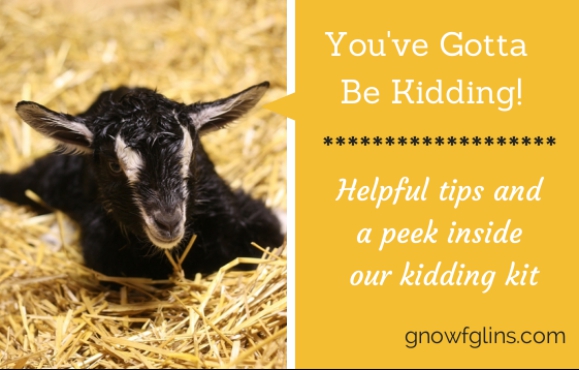
Kidding season is almost upon us at Hickory Cove Farm, and we couldn’t be more excited! Baby goats are simply the best — I can’t wait to meet the kids that I’ve already felt kicking around in their momma’s bellies. This will be our third kidding season, so although I’m sure we’ll learn something new this year, we have a bit of experience behind us.
Today, I want to share how we support the does through their pregnancies, what we keep in our kidding kit, and the tools we use to give the babies the best welcome into the world! I’ll also share what a typical kidding looks like and some resources to help you, just in case things don’t go textbook-perfect.
In case you weren’t aware, a goat’s gestation period is about 5 months, or 150 days. But just like human due dates, there’s window of time for goat births, too. 145 to 155 days is pretty normal. Make sure to keep track of the date(s) your doe was bred so you have a good idea of when to expect those bouncing baby goats to arrive. I use this gestation calculator, and let me tell you, it is much easier than counting out the days on a calendar! 😉
Taking Care of Momma
After your doe is bred — you can check this through a blood test, ultrasound, or the “wait and see” method which involves keep an eye on your doe’s heat cycles, vulva, and growing belly — it’s time to take a look at their lactation status, feed rations, and supplementation. If the doe has been freshened before and is currently still lactating, continue to milk her for up to two months before her due date. Slowly decrease her lactation feed ration when you dry her up, and then slowly build it back up again during the last month of pregnancy. Remember, during that last month, her body is working doubly hard. She has to grow babies and start producing milk again.
It is important to meet the doe’s needs without feeding her too much, since babies who grow too big can cause birthing difficulties. I use this ration calculator to determine how much to feed my does. Dry does don’t need as much feed during early pregnancy, but you’ll need to gradually increase the amount as their due date approaches. Again, use the ration calculator to figure out the best amounts for the particular feed you’re using.
Provide ample calcium throughout the pregnancy so you avoid later complications such as hypocalcemia, toxemia, and ketosis. About a month before the due date, I start to feed my does herbs to support them through the last few weeks and prepare their bodies for giving birth. I use this pregnancy tonic, but birth prep capsules are also great, and even some red raspberry leaf is better than nothing. For kidding day, and to help the doe heal after giving birth, this birth support is a great choice. A bucket of warm molasses water after she’s finished giving birth is a welcome reward for all of her hard work!
A Peek Inside our Kidding Kit
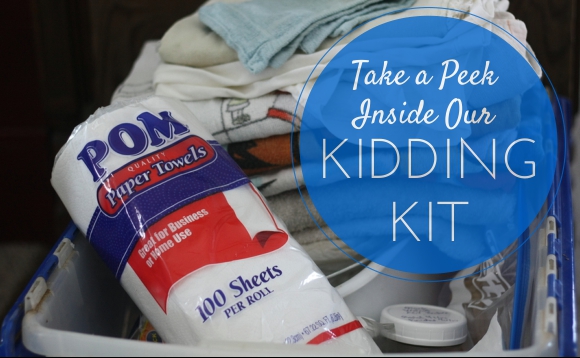
Our kidding kit is a simple plastic tote with a flip-top lid. It stays out in the barn, although anything that can freeze is brought in the house in the winter. The towels are normally wrapped in a plastic bag to keep them clean, but I took them out for the photos.
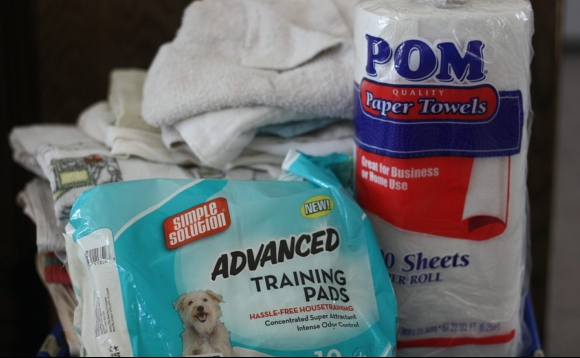
Speaking of towels, make sure you have quite a few! Birth is messy, and you’ll use more than you think you’ll need. They’re great for drying off the kid if momma won’t, or helping her out if it’s chilly, and just for general clean-up. We use paper towels to clean the mucous off of the kid’s face, as they seem to absorb more quickly. Puppy training pads are a great, clean place to lay the newly-born little ones.
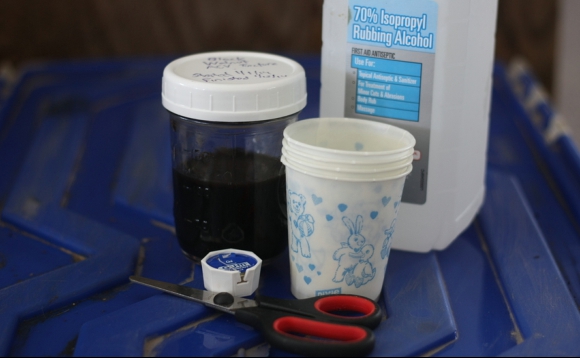
This year, we are going to dip the kids’ umbilical cords in black walnut tincture. I’ve used iodine in the past, but now we’re opting for a better, more natural option. I pour the tincture into one of the cups and then dip the cords. If the cords need to be cut, I use scissors (sanitized by the alcohol) and dental floss. Like the towels, these are kept in a sealed plastic bag and came out only for the photo.
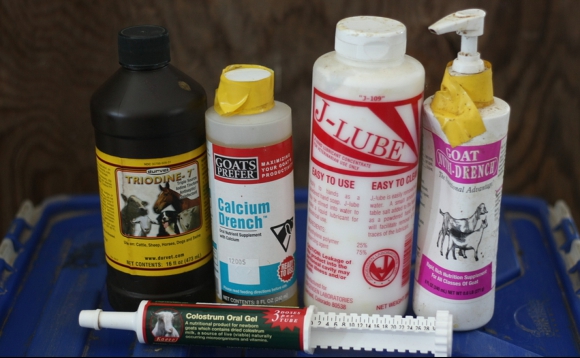
Each of these I purchased for our original kidding kit, and they are still around as a matter of course, but I have since resorted to better, more natural alternatives. As already mentioned, my black walnut tincture has replaced the iodine. The calcium drench is something I bought to have on hand, in case of toxemia and/or ketosis, but it has been replaced by this this herbal calcium formula (which can be purchased here) and a bag of fresh juiced carrots.
In the case of an assisted birth, J-Lube is suggested, but we will use coconut oil if the need arises. Instead of Nutri-Drench, I use cayenne tincture to give energy to a weak kid and doe. (However, I may still use Nutri-Drench occasionally.) I still recommend having some form of colostrum on hand, so if you can’t get any from a friend, powdered replacer or gel will suffice. We have plenty in our freezer now — we always save some for just in case — so I’ll no longer need the gel.
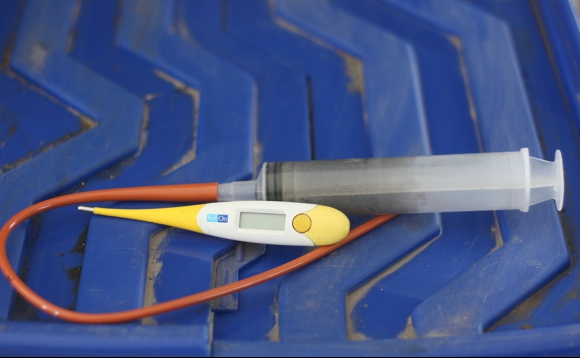
This is a Save-A-Lamb feeding tube and syringe (obviously old and used, but our new one is still in its sterile packaging) and a thermometer. The tube is used if you have a weak kid, or one who just won’t suckle their mother or take a bottle. The thermometer is there to remind you that it’s important to make sure the kid’s temperature is at least 1o1 degrees Fahrenheit before attempting to tube feed them.
During our last kidding season, we almost lost a little buck kid. Thankfully he survived and he is now the daddy of most of this year’s kids! When he was born, after giving him cayenne and bringing him inside to bathe him in warm water to raise his temperature, we tube fed him. He was too weak to take the bottle, so we needed to get that first, all-important colostrum inside him to increase his strength. It was my first tube-feeding experience, and rather nerve-racking at that, but it wasn’t too hard.
Make sure that the tube is in the kid’s stomach and not the lungs, as it is possible for the tube to go down their trachea instead of their esophagus. To tube feed, hold the tube on the outside of the kid’s body and mark the approximate location of the stomach, so you know how far to insert the tube. Next, put the tube, without the syringe attached, in the left side of the kid’s mouth and gently slide it down their esophagus. Do not force it! Stop when you’ve reached the mark you made. To make sure that the tube isn’t in the lungs, put your ear to the tube and listen. If you can hear or feel breaths, take it out and try again.
When you are certain the tube is in the stomach, attach the syringe with one ounce of colostrum and slowly squirt it down the tube and into the stomach. Hold the tube as upright as possible to make sure all of the colostrum is out of it, then pinch it at the top and gently slide the tube out. You may need to do this only once before the goat takes the bottle, or you may need to do it several times, every two hours.
For more info, I recommend this tube-feeding video tutorial.
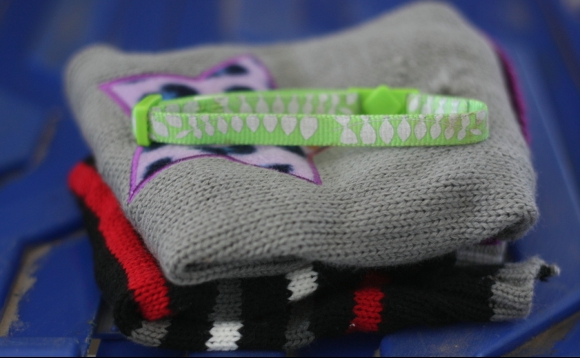
We also keep a few small doggie sweaters and some breakaway cat collars in the kidding kit. We use these mostly to identify any kids who look alike!
If you think you may be out in the barn all night, take a flashlight with you. Also, take a cell phone and the phone numbers of your goat mentors and/or vet so you are prepared to ask for advice if need be.
“How do I know when my goat is ready to give birth?”
This is probably the most commonly asked question by those people who are anticipating their first kidding season. There are quite a few signs to watch out for as the due date comes ever closer, but remember that each doe is different and may not exhibit all — or even any! — of these behaviors. However, keep an eye out for any does doing these common things:
- standing off by herself
- having a “far away” look in her eyes
- she has “lost her ligs” (the ligaments that go from her pin bones to her tail have softened so that you can no longer feel them)
- being more vocal than usual, perhaps turning her head and “talking” to her stomach
- pawing or digging at the ground to create a nest
- laying down, getting up, and re-positioning herself often
- stretching often, perhaps arching her tail at the same time
- yawning
- udder begins filling, getting shiny and tight
- there is amber-colored discharge from her vulva
- she is either significantly more or less affectionate towards you
In my experience, if you know your goats well, you’ll just have a sense that they are ready to kid. There’s really no other way to explain it; when you see it, you’ll know.
If you choose to separate out your does for kidding time, it’s a good idea to prepare the kidding pen a few days before your goat’s due date (about day 140). Make sure the bedding is fresh and clean. When you feel it’s time, move the doe into the kidding pen. This can be at a certain date you’ve picked out — say you want to put her in the kidding pen on day 145 and go on “kidding watch” — or if you’re in the barn and feel like she’s going to be giving birth very soon. We tend to leave the doe with the herd for as long as possible, and move them to the kidding pen during the early stages of labor.
Babies are Coming!
Here at Hickory Cove Farm, we love to stay with our girls while they’re having their babies. However, whether to attend and/or assist your doe’s birth is a personal decision you’ll have to make yourself. For the most part, we find ourselves a spot in the corner of the kidding pen and settle in to watch the miracle of birth. We talk softly to our does, petting and scratching them if they come near and want the attention, and we make sure that we have our supplies and tools ready to go for when the babies arrive. If you are one of the first things the kids see and smell besides their mother, they’ll be bonded to you in some way and will trust you. This is especially helpful if you dam raise your kids as we do, since they won’t need to rely on you to meet their needs.
What a normal kidding looks like
Goats are very adept at giving birth, so they don’t often need any assistance in getting the baby out of the womb and into the world. A normal kidding should look something like this:
As the doe transitions from the early stages of labor into real labor, she’ll have contractions at regular intervals, and pretty soon she’ll start straining and pushing. From the time she starts pushing, the first kid could arrive within five minutes to a half an hour. If she hasn’t made any progress after a half an hour, it’s time to consider moving in to help the momma out, but we’ll talk about that in a bit.
As labor progresses, watch for an amber-colored bubble. It may appear and then disappear back inside the doe. It may even burst inside the doe, and then you’ll only see a gush of amniotic fluids. It’s okay if the bubble bursts during labor, but if the bubble is still intact, look inside for the kid’s feet. They will be covered in a white coating, which prevents their little hooves from hurting their mommas during the birth. If the kid is correctly positioned, you’ll see two hooves, one slightly more forward than the other, and then the kid’s nose on top of its legs. Sometimes the kids tongue is sticking out… so cute! 😉
Sometimes a foot will appear, and then disappear back inside. This is completely fine! I wish I knew this during our first kidding season, but I’ve since learned it’s actually a fairly normal occurrence. (Once you see the kid’s nose and toes, you can lay out a puppy training pad to give the kid a nice, clean landing pad.) Once the doe has pushed the kid’s head out, the rest of the body should follow in one swift swoosh. Congratulations, the first kid is born!
At this point, we like to step in and help the momma out a bit. We clean the “goo” from the kid’s nose as soon as possible, to prevent them from sucking in any of the birthing fluid. Paper towels are very handy because they are dispensable, and they absorb fluids quickly. Momma Goat should be busy cleaning off the rest of the kid’s body at this time, licking and “talking” to her baby, encouraging it to get up and go take its first sips of the needed colostrum. Sometimes we help dry off the kid with an old bath towel or two, especially if the weather is chilly.
If the kid is doing well, check it for possible (albeit rare) physical problems such as an overbite, underbite, or cleft palate. Then lift the tail and check to see if the little cutie is a buckling or a doeling! Also, give each of Momma Goat’s teats a squeeze to loosen up the plug so the kid can nurse properly.
If by this time, your doe has started pushing again, there’s another baby coming! Goats are known for having more than one kid, so be prepared for one (or three!) more babies. Check for more kids by “bouncing” the doe. To do this, make sure the doe is standing up, then stand behind her, facing her tail. Wrap your arms around and underneath her, loosely locking your fingers together just in front of her udder. Gently pull up and bounce her a little bit. If there are more kids inside, you’ll feel something in there, and if not, you’ll just feel squish. 🙂 This is also a way you can feel for kids a month or so before the doe is due.
When all of the kids have arrived and you’ve checked them all over, you can dip their umbilical cords in an antiseptic liquid to prevent bacteria and other nasties from entering the kids’ bodies. As mentioned, I plan on using black walnut tincture to dip cords this year, but this alcohol extract, or this tincture are great alternatives. Usually, the cord either detaches shortly after birth or the doe bites it off. Make sure it isn’t long enough to drag on the ground. If it is too long, tie a piece of dental floss tightly around the cord about two inches from the kid’s body, and cut below the floss with a pair of sterilized scissors. Untie the floss when the bleeding stops. Use some cayenne pepper to stop the bleeding if you wish. To dip the cords, pour the antiseptic liquid into a small paper cup. Pick up the kid, and hold the cup over the umbilical cord and firmly against the kid’s body. Gently tilt the kid backwards/sideways/over, depending on how you’re holding him, to cover the cord and the naval area with the antiseptic liquid.
Watch the kids, ensure that they are moving about and nursing well, and if necessary (or you choose to), bottle feed them. Reward the momma for all her hard work with a nice bucket of warm molasses water and a handful of her favorite treats. Keep an eye on her to make sure she’s passed the placenta within 24 hours following the birth. Most of all, enjoy your new babies!
When the birth isn’t textbook-perfect
Sometimes things don’t go according to plan, and it is necessary to assist the birth. Perhaps the kid isn’t positioned correctly and you have to “go in” and re-position it. Perhaps the kid has one leg bent back, and you have to pull as the doe pushes to get that second leg free. Kidding problems can happen, but they aren’t as common as you may think. If you’ve seen a lot of kidding horror stories on forums or Facebook, keep in mind that most people post only if they need help! You may never know if they’re in the barn and things are going well. 🙂
If, however, you run into difficulties, this is where your goat mentor or vet is an invaluable resource. We had two rough kiddings last year, and much credit goes to our friends and vet who helped us and the does get through them.
If it is necessary to go in and re-position the kid, make sure your fingernails are clipped and your hands are clean, clean, clean! Some people like to use sterile, shoulder-length OB gloves, and some prefer to use their very clean hand. You’ll also need some sort of lubricant. There is always some risk associated with going in. The doe may wind up with a uterine infection, and there’s a slight risk that the person assisting may contract Q fever, which can be passed through birth fluid and the placenta. Pregnant women should not have any contact with an animal’s birth fluids, placenta, or materials contaminated with such things.
There are many graphics and illustrations showing normal and abnormal births on the internet, but my favorite is this set of illustrations and advice. I love them because they really help visualize what needs to be done to get the kids out safely.
Be calm, go slowly, and have confidence that you can get through this. Many people say they find it easier to close their eyes if they need to go in — because it helps them focus on their sense of feel. Don’t hesitate to call for help if you need it. Although some kiddings have sad endings, most assisted births end just as happily as normal births. Learn from your experiences so that you’re even more prepared for the next kidding season.
Do you have animals due to give birth soon? Have you ever had the blessing of observing an animal give birth? Do you have a special story to share? I’d love to hear from you!
...without giving up the foods you love or spending all day in the kitchen!

2 free books:
Eat God's Way
Ditch the Standard American Diet, get healthier & happier, and save money on groceries...
We only recommend products and services we wholeheartedly endorse. This post may contain special links through which we earn a small commission if you make a purchase (though your price is the same).


Thanks for this informative article. We are just beginning to venture into the world of dairy goats, and don’t expect to be directly involved in any birthing this year, but it is likely in our future. 🙂 I really appreciate your sharing what items you keep on hand, with options, and giving us a general idea of the overall birthing process. Very helpful.
Glad you enjoyed it! 🙂
How many goats do you have, and what breed(s)?
Er, none yet, but within the week we expect to have 1 or 2 Nubians. And, as it turns out, one of the does we are looking at is expected to kid by the end of this month (maybe we’re not waiting until next year after all, lol). So, we may be jumping in with both feet, so to speak.
I have one further question, regarding your mention of pregnant women not coming into contact with birthing fluids. Is that to avoid Q fever or are there further concerns involved? My daughter is the one getting these goats, and she is expecting. We’re wondering if you happen to have any resources where we can get more specific info on this topic? Thanks again for all the info you’ve shared with us. 🙂
Q fever is the main concern with in regards to birthing fluids – although brucellosis can also be passed through birth fluids as well, brucellosis has pretty much been eliminated in the US. This article by a vet tech has a good overview of the different risks associated with pregnancy and animal care: http://www.navta.net/files/pregnancy4pg.pdf
I hope all goes well for you in your goat-owning adventures!
I thought I already posted a reply to this, but do not see it now. So I apologize if they both show up. I wanted to thank you for that informative link. It will help us as we further our research. Our search for the right goats for us continues.
And we are planning to stake out our goats in our pasture area for now, by tying them to something heavy, like a tire, during the day so they can browse. We have constructed a shelter for them for nighttime or inclement weather. Thank you again for the helpful info. 🙂
As it turns out, we now have 5 goats: 2 yearling does, 2 does in milk, and one pregnant female, who is due anytime now. So I am reviewing this material. Thank you again. 🙂
We don’t have goats yet either, but I do enjoy watching our neighbors kids. What breeds would you recommend for a beginner and how many to start with? We live on ten acres.
Are you interested in dairy or meat goats, or dual purpose? If you live on ten acres and have a nice area with lots of browse – vines, forested area, etc. that you can fence, or that is already fenced, I recommend going with a standard sized breed. It costs almost as much to feed a mini breed as it does a standard breed and the standards (usually!) produce quite a bit more than minis, so you get a better return, in my opinion. Even though the little breeds are awfully cute…
If you’re interested in meat goats, I don’t own any yet but I’ve done the research and I’ve decided Kikos are the way to go. They’re hardy, parasite-resistant, and are growing in popularity. Kinders, which are a cross between a Pygmy (which is a meat breed, although most people just keep them for pets because of their size) and a Nubian, make a good dual-purpose goat.
As for number -we started with two, one doe in milk, and one 5 month old doeling. You definitely want to start with at least two, as goats are herd animals and do much better when they have a friend. I think that two is a good number to start with to ease into the routine and learn about goats, but remember that goat herds have a strange way of growing quickly… 😉
I think we’d probably be interested in goats for meat as well as for milk. Our acreage is pretty flat though with few trees other than than the ones we have planted. Lots of hay, lots of brush, just no trees. We’d have to fence in the rest of our property and since we have no trees I’m thinking we’d need some sort of shelter too perhaps. Thanks! We’ll keep all this in mind and do some research.
Thanks! We have three Oberhaslis due in the next couple of months so the timing of this article is great. 😉 This is our first kidding season!
Malenksha, have you had any babies arrive yet? 🙂
I need more info on when the doe rejects the kids and wont let them feed ! and the kids wont take the bottle ? we just lost 2. a babe doe and buck